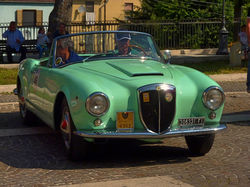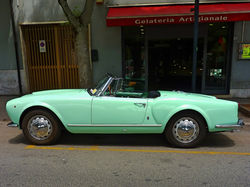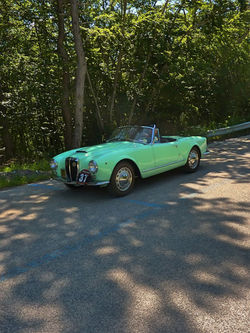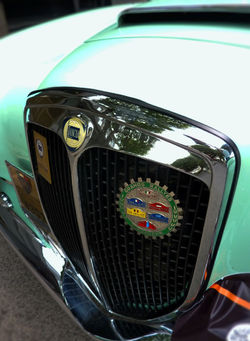
1956 Lancia Aurelia B24 Cabriolet

All photography work is copyrighted by the author, please don't download and publish these pictures in the internet without my permission!
Larger high quality pictures is available only for donators up on request! Vasileios Papaidis 2017 © All Rights Reserved
History of the car
This very special automobile, produced for a scant couple of years during the mid-1950s, offered a host of bristling features in typical Lancia fashion. From the lovely Pinin Farina lines down to the remarkably modern mechanicals, the Aurelia B24 was a guaranteed classic.
The Aurelia series was comprised of a full lineup of first-rate cars, with the B20 GT coupe and B24 Spider stationed at its top. The B20 GT was an influential car in its own right. Automotive author Quentin Wilson recognizes that the car is 'often credited as the first of the new breed of modern postwar GT's.' The model that history has looked upon with the most favor, though, has been the B24, particularly the Spider of 1955.
The B24 Spider offered all the mechanical prowess of other Aurelias, and combined it with the best styling of the series. One of Pinin Farina's masterpieces, the B24 Spider is today one of the most highly regarded Lancias. It was a true roadster with a very basic top and simple side curtains as the only degrees of separation between the driver and the outside world. Yet its ample luggage space and pleasant interior begged for an alfresco getaway into the rich scenery of its Italian homeland.
Featuring monocoque construction, already a Lancia hallmark for decades, the B24 was built by Pinin Farina. That famed carrozzeria of Italy also, of course, penned the elegant lines.
With its tight, lean curves, the Lancia escaped the bulbous trends of the 1950's. At the car's front, the wheels rested beneath sleek pontoon fenders with subtle flares. Those fenders flowed back toward the rear edges of the doors in almost horizontal sweeps before quickly curving up just aft of the cockpit. The rear wheel arches, bulging slightly from the rest of the car, formed tight muscles in a predatory haunch. The B24 Spider's graceful, athletic stance belied its superb poise. The later Convertible model, produced in 1956, added more conveniences like roll-up windows but, while it still looked superb, it sacrificed some style compared to the relentlessly attractive Spider.
There was a terrific attention to detail in the Lancia's design. The way the Spider's split front bumpers led to the proud grille. The way the unfettered rear could have been grown from the soil. The way the delicate curved windshield rested lightly atop the body, an airy marvel of metal and glass placed as if only to frame for driver and passenger the gorgeous view out over the long hood. The Aurelia Spider was fine sculpture at its fastest.
All that elegance translated perfectly into the interior. Free of fussy details, its painted metal dash housed a simple array of instruments and a thin wood-rim steering wheel. The seats took up the width of the interior and, with tops flush with the car's body, blended seamlessly with the B24 Spider's outside.
All Aurelias featured mechanical sophistication that was every bit as impressive as their designs. At the heart of the B24 was a 2451cc V6 cast entirely of aluminum alloy. The Aurelia series brought to market the first ever mass-produced V6, and it was a gem. With its 60-degree V and light construction, the engine would not be out of place in a new car. The phenomenal sound may be unheard of today, but the basic design surely is not.
Vittorio Jano was the man responsible for the development of the Lancia V6, which began life as a 1754cc unit. Jano, an invaluable engineer with Alfa Romeo during the company's all-conquering racing career of the 1920's and 1930's, knew more about designing fine engines than perhaps anyone else at the time. His metallic marvel produced 118hp in the B24.
The engine was not the only impressive collection of moving parts on the Lancia. The car's other famous feature was its transaxle. Incorporating the transmission, differential, and even rear brakes all into one compact unit had several benefits to the car. Most notably, it perfected weight distribution and reduced unsprung weight at the rear axle. The result was a great-handling automobile with ballet dancer balance and razor-sharp reflexes.
Suspending the Lancia was a relatively simple system with a sliding pillar up front. The rear of the car used leaf springs, but a De Dion rear axle ensured the excellent road manners already made possible by the car's light engine and use of a transaxle.
Market values of the Aurelia B24 Spider have reached stratospheric heights, and the cars routinely sell for well over $300,000. These vehicles have become established classics with unrivaled Italian pedigree and prestige. They have rightly become known as some of the best Lancias ever made.
Photo Gallery

























